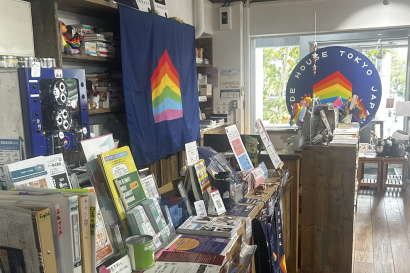After I finish class, I often head to Kanda University’s Self-Access Learning Center (SALC) on campus. SALC is a space for students to improve their foreign language skills. The newly-constructed building is very popular. Every day, students pack every corner of the center to hang out, take snaps, or study. The building also has several classrooms, used primarily for English courses. Professors often send their students out of these classrooms to interview international students on the SALC’s second floor, where only English is allowed.
Because of this, bands of first-year students carrying tablets and approaching international students to have conversations in English are a common sight in SALC. Their interviews are often very interesting, with subjects including everything from relationships to nuclear weapons. And early this month, I was studying alone in SALC when a trio of girls came up to me and asked: “Excuse me, are you an international student?”
It was the first time that I was approached for one of these interviews while alone. Although these impromptu interviews are a normal in SALC, I was truly surprised. Countless times before, I watched Japanese students gathered their courage and approach my fellow IES Abroad students in SALC. But they rarely if ever asked my friends if they were international students. Asian-American students like myself are rarely approached. At times where classes are in session and SALC is relatively empty, I have seen groups of dejected-looking Japanese students fiddling with tablets, unable to find any students who look obviously foreign. Often I’ll approach them and ask, “Excuse me, are you looking for an international student?”
Invariably I am met with a combination of surprise and relief, as the students are eager to finish their assignments. Each time this scenario repeated, I thought to myself: “Ah… so this is what is feels like to be a member of the majority.”
Of course, the reality is more complicated than that. In Japanese, there are two common terms for foreign people: gaijin (外人) and gaikokujin (外国人). Both can be translated to mean “foreigner,” but the two terms have vastly different connotations. Gaijin can be translated to mean “outsider,” while the more politically-correct gaikokujin translates into “foreign national.” Despite the difference, both terms illustrate a powerful cultural norm in Japan: people are either Japanese or non-Japanese. In theory, non-Japanese Asians like myself fall under the latter category, which groups people together regardless of race. But in practice, I have found that I exist in a liminal state, as my foreign identity is sometimes invisible to Japanese people who do not look too deeply. An Asian face and somewhat competent Japanese language skill go a long way towards helping me feel more like a gaikokujin than a gaijin.
Many non-Asian IES Abroad students have expressed opposite experiences. Some have had children stare wide-eyed at them for an entire train ride, whispering “Eigo no hito!” (An English speaking person!) to their mothers. Others have heard older Japanese people openly poking fun at them from behind, assuming a “gaijin” would not be able to understand them. And it feels like everyone has had the experience of shop clerks immediately switching to English when they step up to the counter, no matter how strong their Japanese speaking is.
That is not the case for me. When I go up to the counter, cashiers speak Japanese without hesitation. An English menu is never brought out to me. When I am out with my friends, Japanese people often speak to me first, even though my white friend may actually be much better at speaking than I am. And I have never had seats remain conspicuously open next to me on crowded trains.
Although one may expect that this ability to blend into Japanese society as a sign that I fit in, if anything it has made me feel more American than I ever have before. Frequently my invisibility as an Asian person is dispelled the second I open my big fat American mouth. In America, others have generally considered me to be a quiet person. When I say this to my Japanese friends, they do not believe me at all. Often they suggest that maybe I have become more outgoing since coming to Japan, but I do not think that is entirely true. I think that part of the reason is also that the Japanese and American standards for quiet are different. In Japan Americans are stereotyped as loud and open people, and to an extent I feel that that image describes me. When with my American friends we will sometimes speak loudly and cause heads to turn all around us. And I am never shy about voicing my many opinions about the world.
Realizing my relative loudness is just one of the ways that I have been able to take apart and examine my own identity as an Asian-American while in Japan. In America, I am used to having to resist stereotypes that others define me with. Asian-American identities are sanitized and homogenized to suit the “model minority” myth that holds Asians up as proof that racial discrimination has ended in the United States. The image of a “model minority” person is someone who is economically successful, quiet about politics and social issues, and almost always East Asian. And yet, despite this stereotype, I have always had to resist another persistent American bias that designates Asian people as perpetual foreigners. It feels refreshing when Japanese people ask me “Where are you from?” I say I am from Los Angeles, and that leaves people here satisfied. I never worry about the next question being “No, I mean, where are you really from?”
I am used to analyzing the Asian part of my Asian-American identity, but my time in Japan has allowed me to think more about what makes me American. Just as I navigate webs of assumptions and stereotypes in America, I have had to navigate the different ways that Japanese society categorizes others. I do not think I will ever finish deconstructing who exactly I am and what makes my identity mine, but studying abroad in Japan has allowed me to do so from a different perspective.

Timothy Valero
<p>Timothy is a third-year East Asian Studies/Diplomacy and World Affairs double major from Occidental College in Los Angeles. Prior to studying abroad, Timothy’s studies have centered on historical and contemporary East Asian and Asian American experiences. He further focuses on social movements and minority rights, and is Vice President of Asian Pacific Americans for Liberation, a cultural/political student organization at his home college. He will be spending his time in Tokyo learning about Japan’s unique history and culture, visiting cat cafes, working hard to improve his Japanese language skills, petting cats, eating as much curry rice as possible, and purchasing cute cat-related items.</p>






